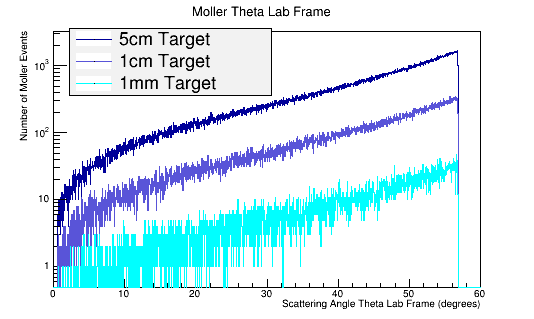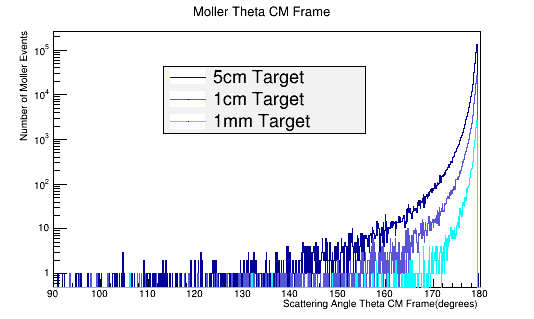Difference between revisions of "Effects Due to Target Length"
Jump to navigation
Jump to search

| Line 1: | Line 1: | ||
As the target material length is increased, the amount of multiple scattering increases. Since the majority of particles created in the CM frame are at large angles, this implies | As the target material length is increased, the amount of multiple scattering increases. Since the majority of particles created in the CM frame are at large angles, this implies | ||
| − | [[File:CompareTargetLength.png]][[File:MolThetaLabTargetLength.png]] | + | [[File:CompareTargetLength.png]][[File:MolThetaLabTargetLength.png|frame|center|alt=Moller Electron Angle Theta in Lab Frame|'''Figure 1:''' GEANT4 Simulation for the Moller electron scattering angle theta distribution for 6E6 incident 11 GeV electrons in the Lab frame of reference. The LH2 target reduces the mean free path of the Moller electron to around 60 degrees in the lab frame. This property of limiting the Moller angle is independent of the target length.]] |
| + | |||
This gives, for LH2 in a 5cm long target: | This gives, for LH2 in a 5cm long target: | ||
Revision as of 16:29, 30 August 2018
As the target material length is increased, the amount of multiple scattering increases. Since the majority of particles created in the CM frame are at large angles, this implies

Figure 1: GEANT4 Simulation for the Moller electron scattering angle theta distribution for 6E6 incident 11 GeV electrons in the Lab frame of reference. The LH2 target reduces the mean free path of the Moller electron to around 60 degrees in the lab frame. This property of limiting the Moller angle is independent of the target length.
This gives, for LH2 in a 5cm long target:
Using the number of incident electrons, for 1 Moller electron:
This gives, for LH2 in a 1cm long target:
Using the number of incident electrons, for 1 Moller electron:
This gives, for LH2 in a 1mm long target:
Using the number of incident electrons, for 1 Moller electron:
